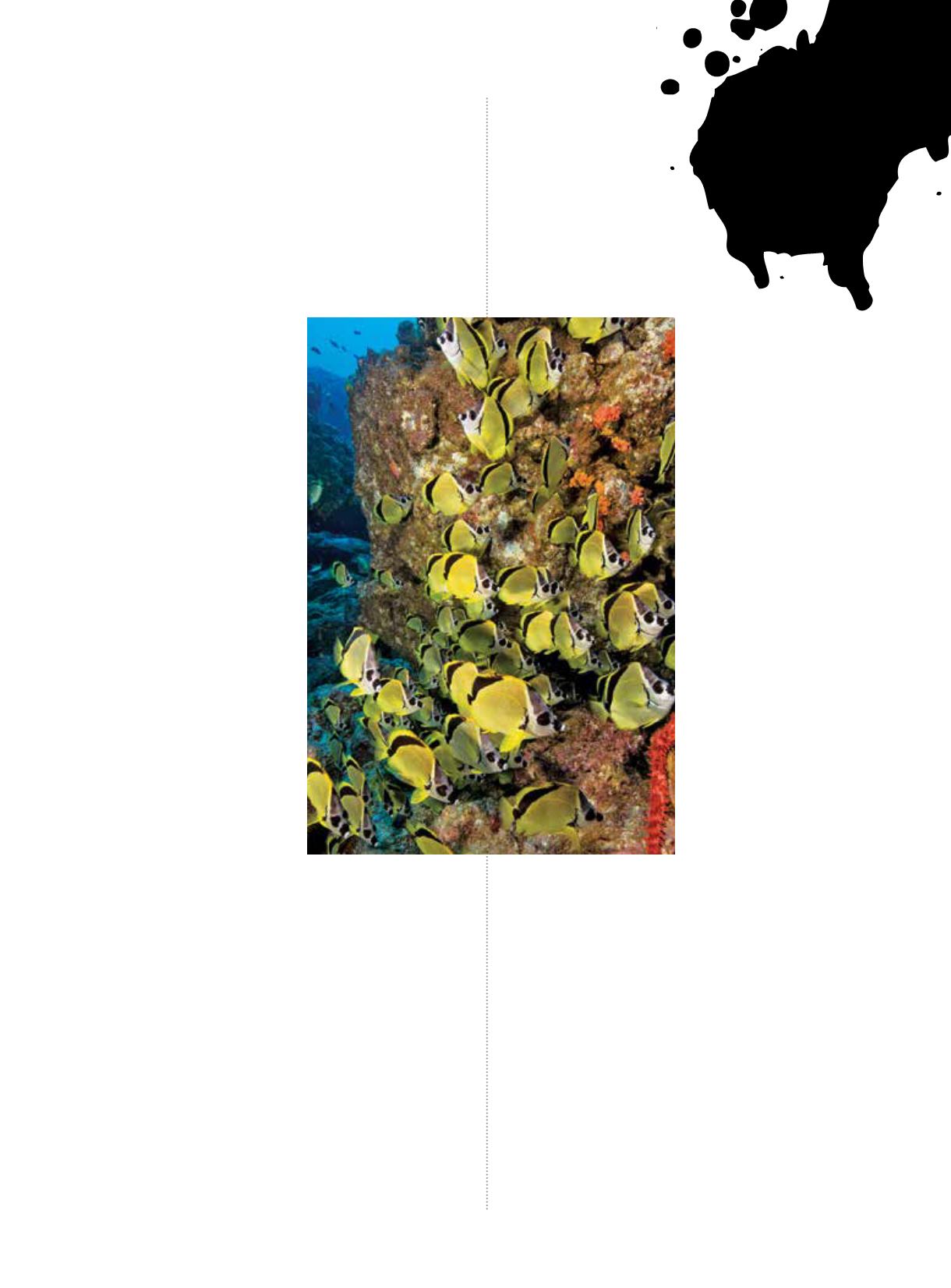
diving during our itinerary. Without it we would have
had to share other sites — many none too large — with
other boats. The Boiler in particular would have been
problematic; it was crowded with only our group of 24
divers. The dive site at Roca Partida is even smaller, and
having two or three boats there at the same time would
be really tricky, especially for encountering pelagic life,
which is the reason we are here. To avoid being the third
boat at Roca Partida one day our captain elected to do
two days at
Cabo Pierce
. This was just fine for it was
very productive, yielding
pictures of a humpback calf,
dolphins, mating octopuses,
large schools of barberfish
and, of course, manta rays.
Cabo Pierce features a
sloping ridge that rises from
deeper than 120 feet almost
to the surface. There are
cleaning stations all along
the ridge; hammerheads
frequent one at 90 feet,
which is where the largest
concentration of barberfish
can be found. Along the
top of the ridge, in about
25 feet of water, the mantas
frequently come in to be
cleaned by clarion angelfish.
While the mantas at The
Boiler seemed to like our
bubbles and appeared to
enjoy interacting with divers,
the mantas at Socorro seem
only tolerant of divers and
much more focused on being cleaned of parasites.
From January through early April humpbacks cruise
these waters. The crew asks divers not to dive down
while on snorkel should they see one, but occasionally
even divers on scuba find humpbacks at their dive
sites, particularly at Roca Partida, where the footprint
is much smaller than the other islands, concentrating
the marine life.
I got lucky one day at Socorro. We saw a mother
and calf swimming rather casually and went out to
join them from the inflatable. The mother remained
motionless in about 25 feet of water and spread her
pectoral fins while the baby swam beneath to find
the teat and suckle. After about five minutes the baby
came up for air. We stayed on the surface to the side
of the whales, and when the baby swam to the surface
— sometimes directly
toward us — that’s when
the photo opportunities
occurred. Typically
the mother will move
away after the first such
interaction, taking baby with
her, but the level of tolerance
is highly variable and greatly
affected by the mother’s mood
that day.
It worked for me that
one day on that one pass. I
figure I had about 12 good
seconds with a whale this
trip, but those seconds may
have been the highlight of
my week. On the second day
at Cabo Pierce I gave up a
dive to try again, but all we
saw were whales in a hurry
to get somewhere other than
where we were. They were
moving with a purpose, and
we never even got so much
as a visible flyby.
The dolphins, on the
other hand, were very
engaged. Both while on
scuba and when snorkeling,
we had frequent visits
from groups of four to six
bottlenose dolphins that
seemed unperturbed by
proximity to divers. This is
very unusual; while we noted some tolerance at The
Boiler, the dolphins at Socorro are on another whole
plane of engagement.
Sitting at lunch and peering through the windows
to see whales breaching or dolphins rolling is
inspirational. Going entire dives with the songs
of humpbacks reverberating through your body is
likewise amazing.
D
ay 5:
Roca Partida
A nine-hour steam separates Socorro and
Roca Partida
.
The rock is the very top of a big seamount that rises
from 10,000 feet to a plateau about 250 feet deep. From
there it terminates at a point about 120 feet above sea
level. It sits in very clear water and hosts a diverse array
Barberfish (Johnrandallia
nigrirostris) form large
cleaning stations for sharks.
Opposite: It is common to see
dolphins playing in the bow
wake as boats approach the
Socorro Islands.
|
73


